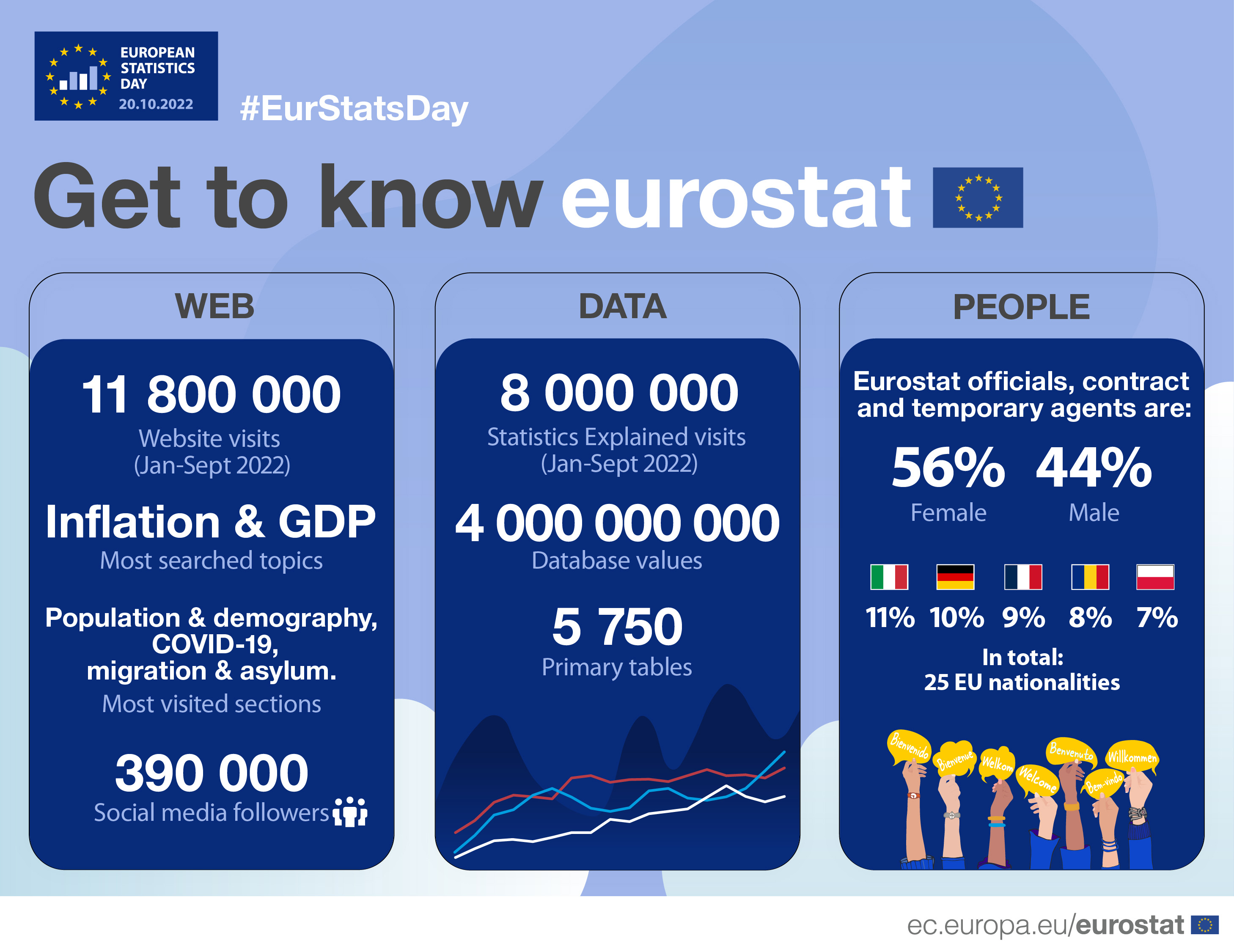Today, we celebrate European Statistics Day, and this is a great opportunity to share with all some data on Eurostat itself.
Statistics have been a part of the European project since the start. First, with the creation of the statistics division of the Coal and Steel Community (ESCS) in 1953 and then with the Eurostat forerunner in 1958. Since then, we have worked to increase our statistical coverage and the channels used to reach all users.
So far this year (January - September), our website registered 11.8 million visits. Topics like inflation and GDP were the most searched, but the most viewed news item focused on minimum wages in the EU (32.070 views).
Of all our dedicated sections, three stood out: population and demography (172 023 page views, between May 2021 and April 2022), the COVID-19 section (151 687) and migration and asylum (104 248).
Our Statistics Explained website had 8 million visits, with 5 million to our articles. The electricity prices and inflation articles gathered the most visits.
We also put at everyone’s disposal all our data through the Databrowser, and here our users were also unanimous: datasets related to inflation and GDP had the highest number of page views. The HICP monthly data by the annual rate of change and index were the most viewed datasets with 126 000 page views and 101 000, respectively, followed by the GDP and main components (output, expenditure and income) with 92 000 page views.
The Eurostat database is updated every day. Figures dated from September pointed to 4 000 million data values and 5 750 primary tables.
Social media platforms have also contributed to bringing EU data closer to all users of all ages. Eurostat now has 390 000 followers across different platforms. We are present on Twitter, Facebook, Instagram, and now also on LinkedIn.
New podcast episode out now: ‘How does Eurostat work”
To mark European Statistics Day, episode seven of our podcast series ‘Stats in a Wrap’ is dedicated to Eurostat. Our objective was to take our users on a small journey through the inner mechanics of the organization and the craft of the people who work here.
The host Jonathan Elliott is joined by John Verrinder, head of unit at Eurostat’s national accounts methodology, and Lourdes Prado, from the government deficit and debt unit, to discuss Eurostat’s official role and the work that we do.
Listen to the monthly episodes on the Eurostat website or on the European Commission Audiovisual Service, or subscribe to our podcast on Apple Play, Spotify, Google Podcast, Podbean or via our RSS feed.
This content is hosted by a third party. By showing the external content you accept the terms and conditions of Spotify.com.
The opinions expressed in the podcasts reflect solely the point of view of the speakers and can in no way be taken to reflect the position of the Eurostat, European Commission, or the European Union.
Check out the interactive publication ‘Key Figures on Europe’
For European Statistics Day, we are also releasing the 2022 edition of the interactive publication ‘Key figures on Europe’ with data for the EU, individual EU Member States and EFTA countries.
Do you want to have a quick and interactive overview of key aspects of the situation of your country? Do you want to compare your country to others? This publication allows you to examine the situation in your country and compare it to other European countries through a range of interactive tools.
The different visualisation tools offer you the ability to dig into selected statistics focusing on people & society, economy & business, and environment & natural resources.
Young people in Europe - a statistical summary
Today, ‘Young people in Europe – a statistical summary’ is also out, presenting some of Eurostat’s most interesting data on young people in the EU and helping mark 2022 as the European Year of Youth.
Divided into six chapters, it includes information on demography, education and training, employment and entrepreneurship, health and well-being, social inclusion, and the digital world through intuitive visualisations and concise texts. A great deal more information can be found when consulting Eurostat Youth dedicated webpage and dashboard.
The European Year of Youth 2022 initiative aims to shine a light on the importance of European youth in building a better future, one that is greener, more inclusive and digital.
Also check out our webinar on statistical literacy and our main economic indicators dashboard happening today between 13:00 and 14:00 CEST.
This online event will be streamed on the Eurostat website and Eurostat Facebook account, and is open to everyone interested. There will also be an opportunity to ask questions via Slido.
For more information:
- Stats in a Wrap podcasts page
- Key figures on Europe interactive publication
- Young people in Europe - a statistical summary
- Statistics Explained website
- What’s New section
- EU dashboard showing youth indicators
- Webinar for European Statistics Day
To contact us, please visit our User Support page.
For press queries, please contact our Media Support.




